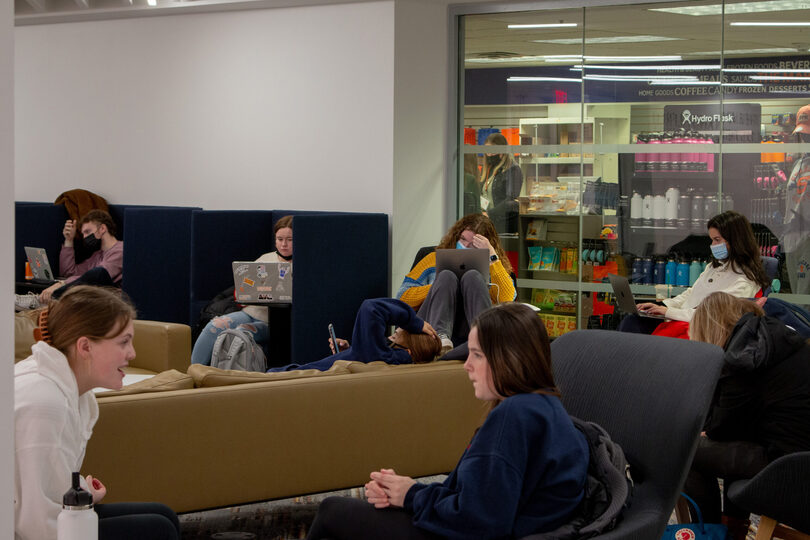Blackboard Ultra pilot wins over SU faculty, official start pegged for 2024

Blackboard promises students and faculty a cleaner interface, more fluid interactions and improved responsive design in its new Ultra update. Last semester's Ultra pilot received positive feedback from SU faculty and students. Meghan Hendricks | Photo Editor
Get the latest Syracuse news delivered right to your inbox.
Subscribe to our newsletter here.
After its first semester of trials in 12 different fall 2022 courses at Syracuse University, a new Blackboard “Ultra” interface is being piloted this semester in 50 more courses and 2,100 students.
Blackboard’s Ultra, an updated version of SU’s current main course management system, Blackboard Learn, aims to have more “intuitive, fluid interactions” and “responsive design,” the platform’s website reads. SU plans to implement Ultra fully in the fall 2024 semester, according to a Jan. 19 SU News release.
Matthew Peters Warne, a senior instructional technology analyst at SU, said advantages of Ultra include a cleaner interface and better scaling for phones and mobile devices, adding that the new version helps instructors create a lot more accessible content.
After positive feedback from the professors piloting the program, the testing pool expanded from 10 in the fall to more than 30 courses this semester. He said feedback from students in those courses was even more positive than faculty.
“We asked the students, ‘What were the downsides?’, and the answer was ‘none, (and) don’t ever make us go back,’” Warne said.
All professors outside of the testing pool currently use the older course-view version of Blackboard, said Warne, who works for SU’s Information Technology Services. While keeping a gradual introduction, he said ITS wants to keep the trial timeline within two years.
To reach the goal of adding only Ultra courses to the Blackboard system by fall 2024, ITS is publicizing the pilot via email and informing faculty that Ultra is now an available service. In addition, ITS is working towards incorporating the First Year Experience courses, including First Year Seminar, in the Ultra pilot.
Mona Eikel-Pohen, an associate teaching professor of German, was involved in the initial pilot program last semester. She said she learned about Ultra through SU’s Summer Institute for Technology-Enhanced Teaching and Learning last summer and decided to participate after seeing the new version for herself.
“I thought, ‘this is so much easier to handle than the old Blackboard,’” Eikel-Pohen said.
Warne said he hopes the SU’s faculty will choose to implement Ultra on their own, outside of rollout efforts by the university. He explained that faculty who have not already opted into the pilot will go through training to be ready to use the new system by the fall 2024 semester.
In her German classes, Eikel-Pohen said her students had an easier time with videos in the Ultra version, which allows users to create short videos and upload them directly into Blackboard without having to switch between screens.
Katie Clinton, who teaches Spanish at SU and joined the Ultra pilot this semester, said she chose to join because she has more time to support students moving over from the older version. The new version has been smoother and more user-friendly compared to Blackboard Learn, Clinton said.
“I went back, and I looked at my Blackboard from last semester… and it felt more mechanical,” she said. “It was much more clunky, whereas this is more streamlined, and it feels like it’s got a more intuitive approach.”
Clinton added that she’s needed to make some classroom adjustments, and that she’s specifically exploring different ways to have students upload work to streamline her grading process.
Though she favors the “cleaner” look of Blackboard Ultra, Eikel-Pohen views some of Ultra’s changes as negative. The new version excludes the colors red and green, which she said makes it bland in terms of accessibility and leads to student complaints that everything looks the same. Clinton added that she’s working to find methods and tricks for the new version to inform her students.
Clinton emphasized the “learning curve” for both students and faculty, saying that patience is needed for a successful transition.
“It’s going to take effort on both the part of faculty and staff and students to make sure that everybody gets what they need and isn’t completely frustrated in the process,” Clinton said. “It’s just a matter of being patient with that … (and) allowing the flexibility and grace to let growth happen, because inevitably growth doesn’t happen without some effort.”





